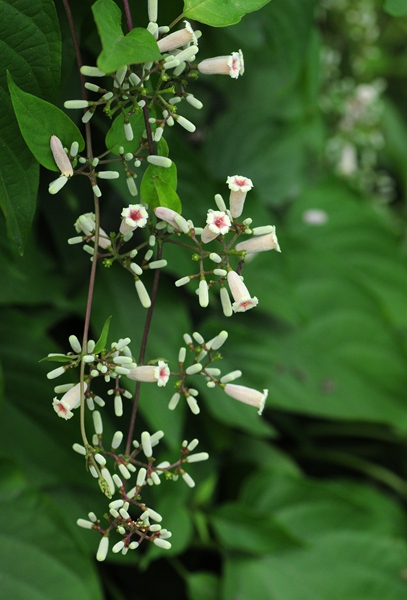
- Scientific Name: Paederia foetida L.
- Ref: Mant. Pl. 1:52. 1767
- Synonyms:
- Apocynum foetidum Burm.f.
- Gentiana scandens Lour.
- Hondbesseion foetidum (L.) Kuntze
- H. tomentosum (Blume) Kuntze
- Paederia amboinensis Miq.
- P. barbulata Miq.
- P. chinensis Hance
- P. chinensis f. microphylla Honda
- P. corymbosa Noronha
- P. dunniana H.Lév.
- P. esquirolii H.Lév.
- P. foetida f. microphylla (Honda) Tsukaya, Imaichi & J.Yokoy.
- P. laxiflora Merr. ex H.L.Li
- P. longituba Nakai
- P. magnifolia Noronha
- P. mairei H.Lév.
- P. ovata Miq.
- P. prainii Gand.
- P. scandens (Lour.) Merr.
- P. scandens var. maritima (Koidz.) H.Hara
- P. scandens f. rubescens Asai
- P. scandens f. rubrae-stellaris Konta & S.Matsumoto
- P. sessiliflora Poir.
- P. stenophylla Merr.
- P. tomentosa Blume
- P. uraiensis Hayata
- P. villosa Hayata
- Psychotria volubilis Roxb. ex Wight & Arn.
- Reussia sarmentosa Dennst.
- English Common Name: skunkvine, stinkvine, Chinese fever vine
- Chinese Common Name: 鸡矢藤/鸡屎藤 jīshǐ∙téng, 臭鸡矢藤/臭鸡屎藤 chòu∙jīshǐ téng, 牛皮冻 niúpí∙dòng, 女青 nǚqīng
- Japanese Common Name: ヘクソカズラ [屁糞葛] hekusokazura
- Family: Rubiaceae
- Genus: Paederia
- Distribution: Forests, forest margins, thickets in ravines and on mountain slopes; 200-2000 m. Anhui, Fujian, Gansu, Guangdong, Guangxi, Guizhou, Hainan, Henan, Hubei, Jiangsu, Jiangxi, Shandong, Shanxi, Sichuan, Taiwan, Yunnan, Zhejiang [Bangladesh, Bhutan, Borneo, Cambodia, India, Indonesia, Japan, N Korea, Laos, Malaysia, Myanmar, Nepal, Philippines, Thailand, Vietnam; also occasionally cultivated, and naturalized in United States (Florida) and perhaps Sri Lanka].
Vines, to 5 m; stems glabrous to densely puberulent, hirtellous, or pilosulous often becoming glabrescent, drying gray to brown. Leaves opposite or rarely ternate; petiole 0.5-9 cm, glabrous to densely hirtellous or pilosulous; blade drying papery to subleathery, ovate, ovate-oblong, lanceolate, lanceolate-elliptic, or elliptic, (1-)5-9(-21) × 1-4(-9) cm, adaxially glabrous to puberulent at least on principal veins, abaxially glabrous to puberulent, hirtellous, or strigillose at least on principal veins, base cuneate, rounded, truncate, or sometimes cordulate to cordate, margins flat, apex acute or acuminate; secondary veins 4-6 pairs; stipules generally persistent, triangular to ovate, 1.5-6 mm, obtuse to acute, acuminate, or rarely bifid. Inflorescences axillary and/or terminal, paniculate, thyrsiform, corymbiform, or cymose, pyramidal to rounded, 5-100 cm, branched to 2-5 orders with higher order axes dichotomous or often scorpioid, hirtellous, strigillose, or glabrous, pedunculate; bracts lanceolate to triangular, 0.8-3 mm; pedicels to 1.5 mm. Flowers sessile to pedicellate in dichotomous to scorpioid, lax to somewhat congested cymules. Calyx glabrous to densely puberulent; hypanthium portion turbinate to ellipsoid, 0.8-2 mm; limb deeply lobed; lobes triangular, 0.4-1 mm. Corolla pale purple, grayish pink, lilac, or grayish white, funnelform, outside densely mealy puberulent or mealy tomentulose; tube (5-)7-10(-17) × 2-6 mm, without slits; lobes broadly triangular to ovate, 1-2 mm, acute. Fruit globose, 4-7 × 4-7 mm, glabrescent, drying gray to yellow; pyrenes concavo-convex to plano-convex. Fl. May-Oct, fr. Jul-Dec. (Flora of China)
